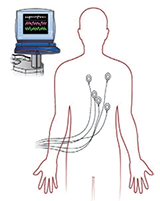A large blood vessel (artery) in your leg has become narrowed or blocked, so less blood and oxygen is getting to the tissues in that leg and foot. An operation is needed to restore blood flow to your leg and foot. Without the operation, your symptoms can become worse. Your leg may become numb or weak. You may develop infection or gangrene, and be at risk of losing your leg.
A leg bypass operation creates a new tube for blood to flow to your leg and foot, bypassing (avoiding) the section of the artery that is narrow or blocked. The new tube is called a graft. A graft can be a vein from your leg or arm (if suitable) or a flexible, artificial tube.
What types of operations can help?
Your femoral artery brings blood to your leg, foot and toes. Two types of an operation on this artery can help improve blood flow in the legs:
- Repair: A narrow or blocked artery in the leg is cleaned out or repaired to improve blood flow. Your surgeon will make a cut in your leg near the blockage in your femoral artery and carefully take the plaque (buildup) off the walls. This will help your leg, foot and toes get blood. All cuts will be closed with stitches or staples.
- Bypass: A new tube is made to make blood go around (bypass) the narrow or blocked section of the artery. A leg bypass can be done in two ways: leg bypass and femorofemoral bypass.
Pre-Admission Visit
You will have an appointment at the
Pre-Admission Clinic within 2 weeks before your operation. This visit is very important to assess your health and help you prepare for your surgery and recovery. Plan for your visit to take 2 to 5 hours. On the day of your pre-admission visit, take your medications and eat as usual, unless you were given other instructions.
What should I bring to my pre-admission appointment?
- Your health card (OHIP card). If you do not have an OHIP card, please bring another form of government-issued photo ID, such as a driver's license or passport.
- Any other insurance cards. You will need the policy number of your extended health insurance, if you have any.
- Your spouse/partner, a trusted friend or family member (to offer you support and be a second set of ears).
- All the medications you take in their original containers. This includes prescription medications, over-the-counter medicines, vitamins, supplements and herbal or natural products.
- A copy of your power of attorney for personal care and/or advanced directives.
- A list of any questions that you may have about the operation and recovery.
- The name or phone number of your pharmacy, as well as any medical specialists that you have seen in the past 3 years.
- If you have had a cardiac stress test, echocardiogram and/or a pulmonary function test in the past 3 years, it would be helpful to bring a copy of the final report with you to this appointment.
What happens during my pre-admission visit?
- You will have blood tests and routine skin swabs. The swabs are taken from your nose and other areas of your body to check for germs that can cause infections.
- You may also need an
electrocardiogram (ECG) to check your heart and a chest
x-ray to check your lungs.
- You will meet many health care providers during your pre-admission visit. Please feel free to ask them any questions that you may have.
- A pre-admission nurse will review your health history and give you information to prepare you for your operation, including directions for cleaning your skin, eating before your operation, taking your medications and pain management.
- A pharmacist will review your medications.
Depending on your needs, you may also meet:
- An anesthetist who will review your health history, discuss your anesthetic plan and pain relief after your operation.
- A member of the medicine team, if you have other complex health problems.
The day before your surgery
- You must have a shower with soap and water to clean your skin the night before and the morning of your surgery to reduce the chance of infection after your operation.
- If you smoke, do not do so for 24 hours before your operation.
- Do not drink alcohol for 24 hours before your operation.
- Remove all nail polish and body piercings.
Stop smoking before your surgery: learn how smoking and tobacco can affect your recovery after surgery, and how
quitting can improve your health.
What Should I do the day of my surgery
Arrive 2 hours before your scheduled operation time.
Surgical Admission Unit (SAU) at
Toronto General Hospital
Peter Munk Building – 2nd Floor
All hospital entrances are open by 6:00 am. However, Elizabeth St. and University Ave. are easiest to access.
After your operation, you will go to the
Post Anesthetic Care Unit (recovery room) where the nurses will care for you until you wake up. When you are ready, you will go to the Step-Down Unit in the
Cardiovascular Intensive Care Unit (CVICU).
What can I expect to have on my body?
You will be attached to some or all of these machines and tubes:
| Incisions, tubes or drains | What to expect |
|---|

|
Heart monitor: You will be on a heart monitor while you are in the Step Down Unit. |

|
Oxygen: You may need oxygen after your surgery. At first, you will have an oxygen mask over your nose and mouth. When you no longer need the mask, you may get oxygen through your nostrils (nasal prongs). |
| Activity | How to manage at home |
|---|

| - Eating well helps your body heal and recover. Eat a variety of foods from the four food groups.
- To prevent constipation, drink lots of fluids and eat foods that are high in fibre.
|

| - Check your incisions each day. You may notice some bruising at first and they may be tender to touch. Keep your incisions clean and dry. Do not put cream, ointment, powder or lotions on your incisions.
|

| - Do not do strenuous activities or lift anything heavy (over 10 pounds or 4.5 kilograms) for 4 to 6 weeks
|

| - Regular physical activity can help you recover and return to your usual activities as soon as possible. Being active also has long-lasting benefits for your health.
- Plan time to rest during the day.
|

| - Do not drive for 4 to 6 weeks after your operation.
- You should only start driving again when you are safe to suddenly apply the brakes in an emergency situation.
|
Where and when
About 1 week after your discharge, you will follow-up with your family doctor.
About 2 to 3 weeks after your operation, you will follow-up with your surgeon's office.
